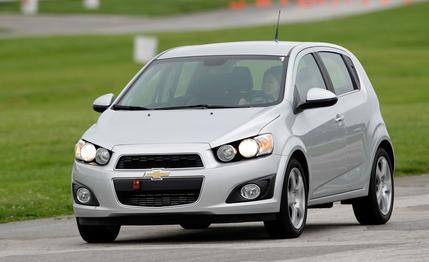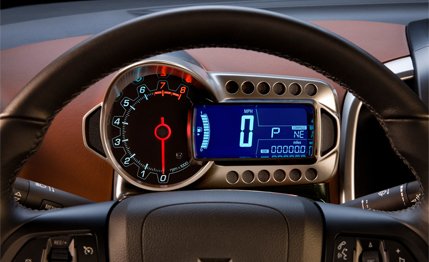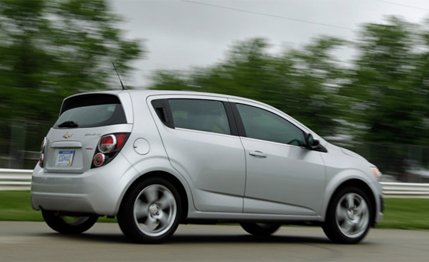
 First Drive Review
First Drive Review
In the subcompact market, things like standard aluminum wheels are big news. Guess what? The 2012 Chevrolet Sonic has standard aluminum wheels. Honestly, we really like that. But in bigger news, Chevy’s forthcoming econobox is actually fun to drive. This is an about-face compared with the outgoing Aveo, which traded exclusively on its bargain-basement price. The Sonic, on sale this fall, seeks to recruit buyers with quality, features, and—to borrow a phrase overused by German car companies—driving pleasure.
A brief disclaimer: Our driving exposure was limited to preproduction prototypes in one configuration (1.4-liter turbo, manual transmission, five-door) on an improvised circuit at Lucas Oil Raceway in Indianapolis, Indiana. In other words, we won’t be able to give you a definitive review until we get more time in a finished production car. But so far the worst thing about Chevy’s new subcompact is the Sonic name. There isn’t much wrong with the actual word, but so many other items in popular culture (fast-food drive-ins, video-game hedgehogs, Seattle’s former basketball team) come more readily to mind than “affordable American car.”
Plenty to Like
Aside from that, there is much to like about the Sonic, most notably the turbocharged 1.4-liter engine we sampled. Shared with the Cruze, the turbo four makes 138 hp and 148 lb-ft of torque, 18 hp and 26 lb-ft more than the Ford Fiesta, a clear rival. And when paired with a six-speed manual, Chevrolet promises a 40-mpg highway fuel-economy rating for the Sonic turbo. The other engine (also sourced from the Cruze) is a naturally aspirated 1.8-liter making the same 138 hp but with a reduced torque figure of 125 lb-ft. The Sonic has slightly different gearing and weighs about 400 fewer pounds than the Cruze, so we expect better acceleration and fuel economy across the board. (In a recent comparison test, an automatic-equipped 1.4T Cruze posted an 8.0-second 0-to-60-mph run.)


The Sonic’s turbo pulls well above 3000 rpm; there is noticeable lag at lower engine speeds, despite a low torque peak of 1850 rpm. Still, it’s a strong, smooth engine. This is not the second coming of the Volkswagen GTI, but the Sonic turbo injects some serious fun in a segment that usually puts performance on the back burner. Chevrolet had a Honda Fit and a Ford Fiesta on hand for comparison, and the Sonic held up well. In lap times, all the drivers present went almost two seconds quicker in the Sonic than in the next-fastest Fit, but some of that is surely due to superior acceleration at higher speeds. The Honda, which is geared shorter, feels better at low engine speeds. And the Ford offers less body roll. But the Sonic looks as though it would acquit itself nicely against the Fit and Fiesta, as well as the Mazda 2. The Chevy’s steering is light and reacts quickly on turn-in. Handling eventually gives way to understeer (the Honda can be tossed around more), but up to the limit the Sonic is responsive and behaves predictably even under trail braking. We’d like a little more feel in the shift lever, but it’s acceptable for this price point.
Should Be Practical and Affordable
The Sonic is an economy car, which means sacrifices in creature comforts. The rear seats don’t have an armrest or cup holders, but they are acceptably habitable even behind a six-plus-footer in the driving position. Both Sonic sedan and hatchback share the same 99.4-inch wheelbase. The four-door, at 173.1 inches, is 14.1 inches longer than the hatch but loses in the space race with 14 cubic feet of trunk space to the hatch’s 19. The hatch also has slightly better rear-seat headroom. The cargo area in the five-door, although not as spacious or ingenious as the Honda Fit’s, has a removable false floor that creates a level surface when the seats are folded. There is also a slot for the cargo cover to slide into behind the rear seats.


Chevrolet won’t divulge Sonic pricing until the fall on-sale date gets closer, only hinting that it will be competitive in the segment. We take to that to mean a starting price of about $14,000 and, as is the case with Fiesta and Fit, loftier trim models (including the turbo) that run as high as $19,000. Also like the Fiesta, we’re guessing the Sonic hatch will command a premium for its more attractive looks, although we have to say that the Sonic sedan manages to look something less than dumpy—a huge achievement in this segment. Even in base LS trim, the Sonic comes with the aforementioned wheels, plus air conditioning, power locks, keyless entry, stability control, and an impressive 10 air bags.
We’re not quite ready to break out the “super” prefix for the Sonic, but it does appear to mark the return of the American small car, and not just in name. As part of GM’s restructuring, the Sonic will be assembled in Lake Orion, Michigan. The good news for Chevy, however, is that the Sonic appeals on its merits as a car and not as a piece of flag-waving patriotism.